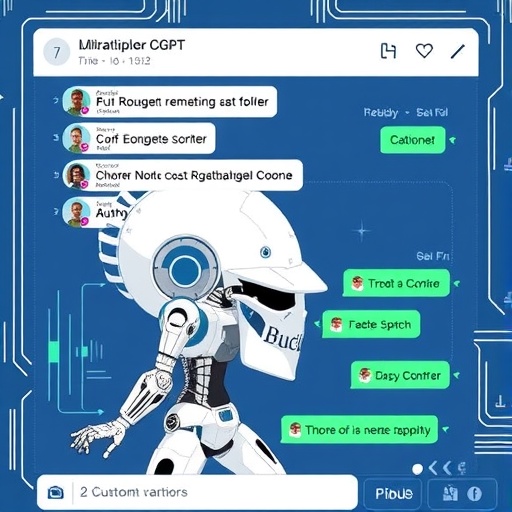The rapid advancement of artificial intelligence has led to the widespread utilization of large language models, such as ChatGPT, Claude, and others, in various contexts ranging from professional tasks to personal entertainment. Enthusiasts and professionals alike have marveled at the capabilities of these models, drawn to their elegant use of language, coherence, and promise in transforming the way we interact with technology. However, a growing body of research indicates that despite their impressive functions, these systems often struggle to convincingly mimic human conversation.
Recent findings from a study involving researchers from the Norwegian University of Science and Technology and the University of Basel reveal critical flaws in the ability of large language models to emulate human conversational patterns authentically. The study, rich in insights, systematically analyzed and compared transcripts of authentic human phone conversations to those simulated by language models. The researchers sought to discern whether individuals could recognize the differences and distinguish between genuine human dialogue and AI-generated responses. The results were quite telling: most participants could identify the artificial nature of the model-simulated conversations.
One of the key aspects wherein these models falter is the phenomenon researchers refer to as “exaggerated alignment.” While humans generally engage in subtle forms of imitation during dialogues, adapting their language and delivery based on contextual cues and the responses of others, large language models tend to overdo this mimicry. This attribute leads to conversations feeling disjointed, overly mechanical, and, ultimately, inauthentic. The models, in their quest to optimize conversations, fail to embrace the nuanced fluidity that characterizes real human interaction.
Additionally, the study highlighted that language models demonstrate an inconsistent and often incorrect application of filler words – those small yet socially significant terms such as “you know,” “like,” and “well.” In everyday conversation, these markers serve critical functions; they convey engagement, structure discourse, and indicate emotional undertones. Unfortunately, large language models struggle to employ these words accurately and flexibly, frequently misusing them. This contributes to their inability to create an atmosphere reminiscent of genuine human dialogue and serves as a telltale sign of their artificial nature.
A major distinguishing feature of human conversation is the manner in which individuals initiate and conclude discussions. Humans rarely dive directly into the core of a topic without preliminary small talk or social niceties. Instead, one might say, “Hey! How have you been?” before transitioning to more substantive matters. This organic flow is not typical of large language models, which lack the ability to navigate these conversational transitions seamlessly. When it comes to concluding conversations, humans typically engage in polite farewells that help in forming connections. In contrast, language models tend to represent discussions in a more sterile manner, which can lead to an abrupt and jarring conversation closure.
The researchers assert that these shortcomings serve as glaring indicators of the artificiality inherent in large language models. Participants in the study were often acutely aware of the nuanced differences, suggesting that AI-driven responses can feel far too calculated or overly simplistic. Language models, in their attempts to generate content, often miss the subtleties that embody authentic human communication, a testament to their technological yet non-human origins.
Despite these limitations, the field of artificial intelligence is evolving rapidly. Each iteration of language models seems to build upon previous frameworks, attempting to narrow the gap in conversational authenticity. Researchers are optimistic that improvements and new methodologies will undoubtedly enhance the capabilities of these systems. However, they admit that while models might get better at mimicking human conversations, essential differences will likely remain. Understanding the intricacies of human communication is a complex task, and despite advances, replicating this experience fully may prove elusive.
As we progress, it becomes vital to consider the ethical implications of improving language AI and their potential role in society. While the convenience and efficiency brought forth by such technologies can have profound benefits across various sectors, from education to customer service, there lies a risk of dehumanizing interactions. The development of AI should not only aim at elevation in capabilities but should also be conscious of the underlying human experience it intends to emulate. A balance must be struck to harness the power of artificial intelligence while preserving the essence of genuine human connection.
In summary, while large language models have showcased immense potential, their recent evaluation sheds light on their limitations in simulating authentic human conversation. Current models remain incapable of consistently fooling us into believing we are interacting with a real person. The future holds promise for these technologies as advancements will probably reduce the disparity between human and artificial dialogue. Nonetheless, fundamental differences will likely endure, reminding us of the unique complexities inherent to human interaction.
As society navigates through these advancements, ongoing research and meaningful discourse will be essential in determining how we embrace and regulate the growth of language models and their applications. Bridging the gap between artificial and human communication could one day become a reality, but whether we should cross that threshold remains a pertinent question for future ponderings.
Subject of Research: The ability of large language models to simulate spoken human conversations
Article Title: Can Large Language Models Simulate Spoken Human Conversations?
News Publication Date: 1-Sep-2025
Web References: PMC
References: Mayor E, Bietti LM, Bangerter A. Can Large Language Models Simulate Spoken Human Conversations? Cogn Sci. 2025 Sep;49(9):e70106. doi: 10.1111/cogs.70106. PMID: 40889249; PMCID: PMC12401190.
Image Credits: Not applicable.
Tags: artificial intelligence in communicationconversational patterns analysisexaggerated alignment in AIflaws in AI conversational abilitieshuman-like interaction challengesidentifying AI-generated responsesimplications of AI in personal interactionlarge language models comparisonlimitations of ChatGPTmimicking human conversationresearch on AI dialogueunderstanding AI’s communication gaps





